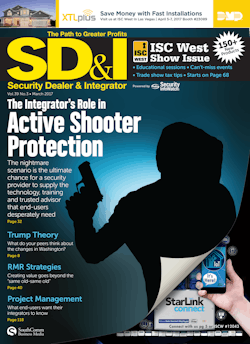The Integrator’s Role in Active Shooter Protection
It was a normal day at Ft. Lauderdale’s Hollywood International Airport until the shots rang out. Pandemonium ensued. A man was firing a Walther PPS 9mm semi-automatic pistol at travelers in the baggage claim area. The terror lasted a little more than a minute, and then it was over. The shooter was out of ammunition. He laid on the ground and waited to be arrested; meanwhile 11 innocent people also lay on the ground – injured or killed by the bullets.
To say this is the worst-case scenario for your security clients is an understatement. This is the nightmare. And while some facilities are inherently safer than others, the active shooter scenario is indiscriminate – it can touch any facility or vertical market, whether a hardened courthouse, an open house of worship, or a school, corporate campus or airport.
“It used to be workplace violence and internal theft were the top two threat profiles,” says Carey Boethel, president and CEO of Securadyne Systems. “Today, an active shooter scenario is what keeps people up at night, and being able to prevent that is extremely difficult, if not impossible.”
It is not enough in 2017 to simply sell, install and maintain security systems. Today’s security integrators must embrace the trusted partner mindset when it comes to the active shooter – and many forward-looking firms have done just that, in the form of training and technology. While this article focuses on just three of hopefully many integrators who are taking an active role in mitigation of this threat for their customers, the question remains: How much is your firm doing?
Active shooter events have increased in frequency every year since 2000, according to FBI data. Prevention of active shooter incidents in a free society is, in most respects, unattainable; however, security integrators certainly have an evolving and expanding role in active shooter response and mitigation – and an inherent responsibility to make sure their security director clients and personnel are ready to deal with the nightmare scenario.
The Technology Angle
Unfortunately for all of us, active shooters are extremely difficult to prevent; in fact, those discussions are probably better left to politicians, mental health experts and other pundits. For the security integration firm and its customers, the focus is on response and mitigation.
The first prong of that strategy is technology. As is customary for security integrators, recommending, installing and maintaining access control, video and communications systems is paramount.
“The most popular technologies are for communication,” explains Scott Lord, Director of Innovation and National Accounts for Kansas City-based All Systems. “As end-users integrate active shooter processes into their emergency response plan, the one vital need that is quickly apparent is the ability to clearly and quickly provide information to the building occupants. Overhead paging, intercom and emergency communication systems are hot technologies today.”
Adds Shawn Reilly of Atlanta-based Tech Systems: “When you are talking about an active shooter, the better integrated a security systems is – and knowing where all alarm points and video cameras are – the better security forces in the control center are able to do immediate security assessments, track the shooter, and help direct first responders. It is about being able to communicate the location of the threat and then responding effectively to that threat.”
While communications is all about the response aspect, new technology developments are greatly aiding in the actual detection of active shooter events. “Our role in active shooter response has changed recently,” says Josh Baker, a security consultant with The Protection Bureau. “From a physical security standpoint, we have primarily been concerned with things like how an access control system or video system should automatically respond or how a security operations center should respond to an incident. What we have seen recently are some new product developments to really help start that process.”
Baker is referring to indoor gunshot detection technologies, and says they are having the greatest impact on the integrator’s role in active shooter response. Up until now, Baker explains, if a lockdown procedure needed to be initiated because of an active shooter, end-users had to be reliant on somebody noticing that something is happening, and then notifying the security department – either via a panic button or other means – which then initiated a lockdown. “These new devices are enabling that to all be done automatically,” Baker explains.
Indoor gunshot detection systems – a relatively new technology on the security scene offered by a small group of vendors – are a natural evolution of more established outdoor systems that were marketed primarily to cities and large corporate/university campus environments. “We have been working with a product that uses two-factor authentication – audio and visual – to look for both the acoustic signature of the gunshot and the IR flash that is associated with it,” Baker says.
The devices are about the size of a standard horn strobe with the audio and visual detectors built in. They sit on the network and are integrated with an access control system. When a gunshot is detected, the devices can initiate an automatic lockdown event that may include audio/visual notification (horns and strobes), automatic closing/locking of doors, changing of security clearance levels and more.
“In a similar way to initiating devices on a fire system, it allows these policies and procedures to be implemented automatically from a technology standpoint,” Baker explains.
The detection devices can be installed throughout a facility. The devices pick up the shots as the shooter moves, and give up-to-the-second locations of where those shots have been fired to a command center. This can also be supplemented with video camera coverage.
“Tracking is of high importance,” Baker explains, “so when law enforcement responds, the local security teams can give as much information as possible as to where that threat is.”
Embracing new technology to solve a problem is a tried-and-true concept for security integrators, and as such, they know that customer education becomes one of the most important aspects. Baker says The Protection Bureau takes an active role in educating customers about new technology developments both through face-to-face meetings and live demonstrations.
“We have live-fire testing events at our facilities, where we will bring in clients and local law enforcement to demonstrate the technology and show them how it works, how the devices function, and how they can tie it into an existing access control system,” Baker says.
End-User Training
As Baker illustrates with the live demo events, an integrator’s continuing quest to become the trusted security advisor for any end-user tends to go far beyond simple technology deployment. While it may be less common, providing hands-on training to end-users is emerging as an integral piece when it comes to the integrator’s role in active shooter response and mitigation.
“I have not seen many integrators who conduct actual active shooter response scenarios or trainings,” says All Systems’ Lord. “This was a growing problem for our organization – school districts wanted to enhance their security, but did not have solid processes in place for an active shooter scenario.”
In 2014, Lord discovered the ALICE (Alert Lockdown Inform Counter Evade) active shooter process – a comprehensive training program on how to institute a process for active shooter events. “I became certified as an ALICE trainer, and we have been sponsoring certification classes in our area,” Lord says. “We usually do two to three classes per year, in which we invite school district and law enforcement personnel to attend.”
“It is important to work with local law enforcement and consulting agencies to understand how customers are most likely to implement a response to an active shooter scenario,” Baker adds, “because although security, quick notification and lockdown is vitally important, it is just as important for that customer to do testing and to make sure that security departments and employees understand how they should react in a given situation.”
Tech Systems has taken this a few steps further. Reilly has a veritable alphabet soup after his name. In addition to the ASIS CPP and PSP certifications, he is a Certified Healthcare Protection Administrator (CHPA) and is certified in Crime Prevention Through Environmental Design (CPTED). He joined the company in 2013 after being Chief of Police and Director of Security for the Greenville (S.C.) Health System. As Chief of Police, he led a 16-man police force that provided law enforcement services to the University Medical Center. As security director, he was responsible for a 130-man security force which was deployed to all campuses.
“We used a state law to establish the health system as a police jurisdiction,” Reilly recalls. “I remember explaining it to our CEO, and he asked why I couldn’t be the Chief of Police. I told him I’d have to go through the police academy – he said, ‘so what?’ So I did, and I got a lot of training in risk assessment for active shooter scenarios.”
When he joined Tech Systems, the company thought it would be a great value-add if Reilly could give active shooter training to clients. “That was four years ago,” Reilly says. “Since then, the company has been all about helping me continue to get trained on the other aspects.”
After completing FEMA and ALICE training, Reilly now travels around the country doing risk assessments, active shooter training and training program development for Tech Systems clients as part of the company’s service and maintenance agreements. “We’re a partner with our client,” Reilly says. “It is just so much broader than installing cameras and access control. They hired me and many other former security directors because they bring to the fight a lot of the experiences that you’ve never had if you are just an integrator installing cameras.”
A common misconception is that security directors and end-user organizations have a tight handle on law enforcement-type training and risk mitigation. “There are companies who have opted to have their facilities or engineering person also wear the security director’s hat – a lot of our data center clients have people like that,” Reilly explains.
But even for clients who have a security director with years of law enforcement experience and the qualifications to conduct the training themselves, the sessions are invaluable. “He will look at me and say, ‘I just don’t have time to do this,’” Reilly says. “It is not always a question of knowledge or qualifications – if the client has someone else (conduct active shooter training), they have more time to do other things.”
Inside an Active Shooter Training Scenario
What does Lord or Reilly’s average training session for look like? It starts, of course, with the attendees. Reilly is typically instructing employees of a facility, although he says there are times when a client separates the managers/supervisors, who then communicate the training lessons to the rest of the employees.
Reilly says he takes little pieces of all the different training programs and strategies he has learned over the years and incorporates them into a single program. Inevitably, much of the individual employee training focuses on the common, “run/hide/fight” scenario. He says that the first and best option is to run if possible; fight if you have to; and hide as a last resort.
It may look like this: “I have someone who is experienced handling a firearm to come into a room with a NERF gun, and everyone is hiding under their desk, and he just methodically shoots everyone,” Reilly explains. “Then, I send the ‘shooter’ back out of the room and this time I give everyone under the desks foam balls and I tell them to throw them at him. When the people throw their balls, the shooter is flinching and he is much less accurate. Now if you are into it, you are scared – it is amazing how real it seems.”
That’s just the individual training. Reilly also sits down with management to create a true response plan. “If you have an active shooter in the building, that’s not the time to say, ‘we’ve got to go get a plan put together,’” he says.
He trains them and helps put an active shooter response plan in place that involves multiple stakeholders, including HR, security, operations and management. Then, he facilitates a table-top exercise that includes law enforcement, where the plan is examined step-by-step. “Once they are happy with that, then it is time to actually do a live exercise,” Reilly says, which includes a simulated active shooter, law enforcement response, and the employees are asked to practice what they have been trained to do.
Resources for Integrators
It is a granted that not every integrator has a former police chief and security director on hand to conduct training, but there are plenty of resources to utilize to become better informed about the nightmare scenario and how to respond to and mitigate it.
Whether an integrator plans to offer training or not, being more informed on the topic will obviously help in communicating the vision of a complete active shooter response and mitigation plan/recommendation for a client.
In addition to the ALICE program (www.alicetraining.com), be sure to consult law enforcement organizations such as FEMA, DHS and the FBI. ASIS International also offers web-based training.
Lord says integrators may also want to investigate Strategos International (http://intruderresponse.com), which specializes in active shooter training and response.
Lord also recommends the Partner Alliance for Safer Schools (PASS) School Security Guidelines (www.passk12.org), which assist in creating the “team” needed to implement processes and technology into a cohesive and effective deterrent for active threats. PASS works in conjunction with Safe and Sound Schools (www.safeandsoundschools.org) – an organization started by one of the mothers who lost her child in the Sandy Hook tragedy – that provides simple, effective methods to schools for active shooter scenarios.
“There are always people at my trainings who say, ‘that will never happen here,’” Reilly concludes. “I tell them: This is a low-probability, high-consequence event – the chances of someone actually being involved in an active shooter event are very low, but if you are, the consequences are devastating.”
Paul Rothman is Editor in Chief of Security Dealer & Integrator (SD&I) magazine. Access the current issue, full archives and subscribe at www.secdealer.com. Pick up a free copy of SD&I at ISC West Booth #17141.







